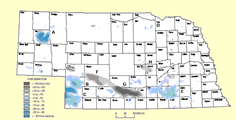Natural Resources, School of

Conservation and Survey Division: Faculty and Staff Publications
Document Type
Article
Date of this Version
2-11-2019
Citation
Hallum, D.R., 2019, Informing water use decision-making for waterfowl and agricultural production on a ranch along the North Platte River, Nebraska. University of Nebraska-Lincoln, Conservation and Survey Division, Open File Report 205, 276 pp.
Abstract
In 2014, operators of a ranch along the North Platte River approached Conservation and Survey Division seeking expertise to interpret data collected on their ranch. The interpretations inform ranch decisions to accomplish operators’ goals. This publication documents the work by: 1) characterizing the ranch, 2) summarizing data collected, 3) characterizing hydrogeology of the site and the adjacent reach, and 4) conceptualizing groundwater/surface water interaction.
The ranch is a recreation property and a migratory waterfowl refuge with a few general goals: 1) develop and maintain high-quality wet meadow habitat, 2) maximize the extent and duration of surface water on the property in existing wet meadows, sloughs, and ponds, and 3) maintain a level of agricultural production that can be used to mitigate costs.
An adaptive program of data collection and synthesis was developed and implemented from 2014 to 2019. It is ongoing. Groundwater data collection began in 2014. Weather and stream data collection began in 2015. Weather data was served to the internet in 2016. Radio telemetry was added to groundwater and stream data in 2017 and discontinued in 2018. Summaries of collected synthesized data began quarterly and currently occur monthly. The observation network at the ranch currently generates about 15,000 records a month at seven locations.
Hydraulic relationships at the ranch are more complex than initially conceptualized. Water table configuration indicates flow in unexpected directions, groundwater response sometimes precedes surface water response to precipitation, and stress responses can vary seasonally. Stream/groundwater response to precipitation is distinctly non-linear. The vadose zone is generally thin, yet may have significant influence on observations.
The ranch has successfully developed diverse habitat features on the site including wet meadows, ephemeral stream channels, sloughs, grassy and woody hummocks, and ponded areas. These areas are populated by varieties of ducks, geese and herons, as well as many other riparian, woodland, and grassland species, including beneficial invertebrates. Culverts have been installed along many of the channels and sloughs such that the water level in upstream segments can be managed to change the stream or slough stage in reaches where water is flowing. The groundwater/surface water storage dynamic can therefore be managed to maximize habitat and wildlife benefits as well as groundwater storage and return flow. Much work remains.
Included in
Geology Commons, Geomorphology Commons, Hydrology Commons, Paleontology Commons, Sedimentology Commons, Soil Science Commons, Stratigraphy Commons


Comments
OFR-205